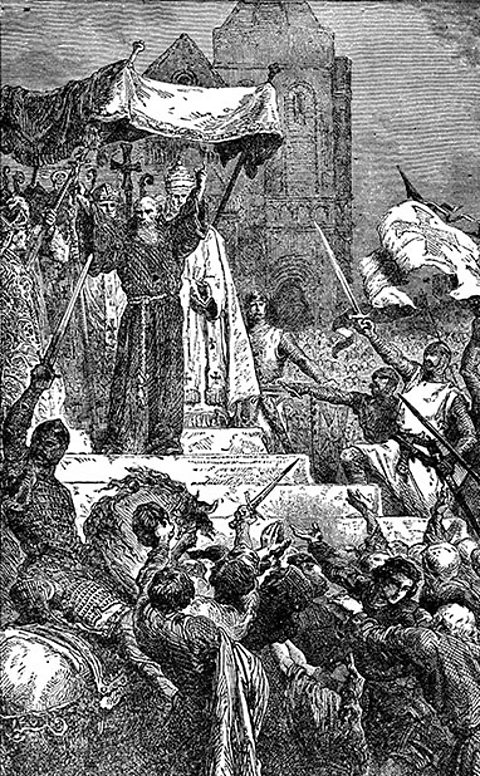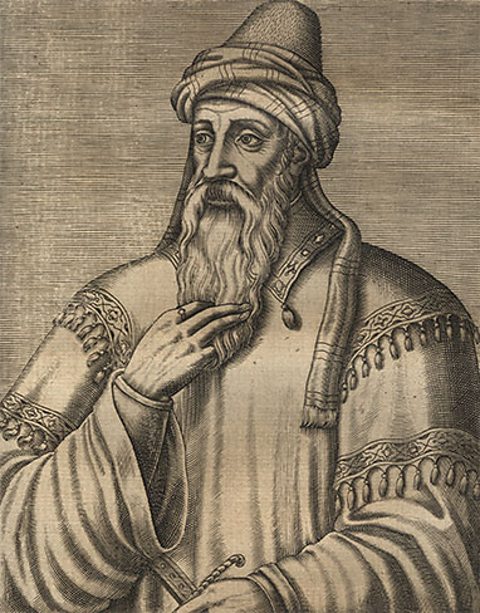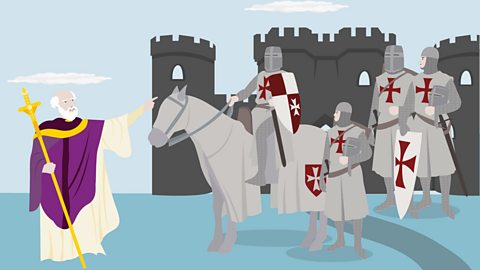Key Points
- In the medieval era, there were several CrusadesMilitary campaigns undertaken by Christians who believed that it was possible for them to 'reclaim' the Holy Land for Christianity from Islam. Muslims who lived in the Holy Land regarded the arrival of these Christian soldiers as an invasion. made by people from European Christian countries.
- Crusaders believed they were carrying out their God's work by taking part in military campaigns to âreclaim' the Holy LandPlaces around Israel and Palestine connected to the birth and life of Jesus. for Christianity. They followed the wishes of the Pope - the head of the Catholic Church.
- People who went on the Crusades were motivated by different reasons including the prospect of wealth, freedom or power.
- Key figures involved in the Crusades included Richard the Lionheart and Salah ad-Din who was known to the Crusaders as Saladin.
The importance of the Holy Land
In the Middle Ages, the Islamic worldSocieties, cultures, and peoples that share a common Islamic heritage and practice the Islamic religion. stretched from stretched from India, in South Asia, to Spain, in Western Europe, and included Jerusalem and the Holy LandPlaces around Israel and Palestine connected to the birth and life of Jesus.. For Jewish people, Christians and Muslims, Jerusalem was and still is a holy city and a destination for pilgrimageA holy, or, religious journey..
For Christians, Jerusalem is the place where they believe Jesus died and was buried. Christian pilgrimA person taking part in a pilgrimage - a holy or religious journey. had come to the city for centuries.
To Muslims, it is considered to be a holy site, where they believe Prophet Muhammad ascended to Heaven from Jerusalem. Arab Muslims conquered the Holy Land in 638. The Dome of the Rock and the Al-Aqsa mosque are sites of pilgrimage for Muslims.
For Jewish people, Jerusalem is important it is seen as the centre of the world, and is believed to be the site where Abraham, the founder of Judaism, was prepared to sacrifice his son, Isaac, as God tested his devotion to his faith.
The CrusadesMilitary campaigns undertaken by Christians who believed that it was possible for them to 'reclaim' the Holy Land for Christianity from Islam. Muslims who lived in the Holy Land regarded the arrival of these Christian soldiers as an invasion. were not only significant for religious reasons - they were also politically significant. European rulers believed success in âwinning backâ the Holy Land would secure their power and legacy as a successful leader. The Crusades were encouraged by the Pope, so leaders also believed they were doing Godâs work by fighting for control of the Holy Land.
The Crusades were economically significant too. They opened up new opportunities for trade. Crusaders brought back new spices and textiles from the Holy Land and the wider Islamic world. New trade routes were established, meaning more goods could be bought and sold both across Europe and with the Middle East.
The routes of the Crusades
Early conflict

Around 1077, Muslim SeljukA person from or something relating to the Seljuk Empire which was a large empire of Islamic countries, stretching from Turkey, through the Middle East and into Asia. The Seljuk Empire gradually conquered land from the Byzantine Empire from the 11th century. Turks took control of the Holy LandPlaces around Israel and Palestine connected to the birth and life of Jesus.. It became harder for Christian pilgrimA person taking part in a pilgrimage - a holy or religious journey. to visit as various Muslim groups struggled for power.
The Seljuk Turks saw Christian presence in the Holy Land as a threat to their authority. They imposed taxes and charges on Christians wanting to visit holy sites. Rumours of mistreatment of local Christians and pilgrims spread. The ByzantineA person from or something relating to the Byzantine Empire. An empire based on the remains of the Roman Empire, its capital was Constantinople (present day Istanbul) and the official religion was Christianity when it was founded in 330AD. Conquered by the Ottoman Empire in the 15th century. Emperor, Alexius, fearing the spread of Seljuk rule towards lands he controlled in south eastern Europe and a threat to the Christian city of ConstantinopleCapital of the Byzantine Empire. Present day Istanbul was previously Constantinople., appealed to the Pope for help.
In 1095, Pope Urban II promised the knights of Europe forgiveness of their sins if they went on a CrusadesMilitary campaigns undertaken by Christians who believed that it was possible for them to 'reclaim' the Holy Land for Christianity from Islam. Muslims who lived in the Holy Land regarded the arrival of these Christian soldiers as an invasion. to win back Jerusalem for Christianity. He:
- wanted to reclaim land and prevent further expansion of the Islamic kingdoms
- felt that any expansion of Islamic kingdoms was a threat to the Christian countries under his guidance
- believed the Crusades would help to unite Christian countries in Europe, who were frequently in conflict with each other
- knew the Crusades would financially benefit the Church

How might a Crusade financially benefit the Church?
In the medieval period, peasants had to give 10 per cent of what they produced on their land to the Church. If the Church controlled more land by gaining territory in the Middle East, the people who lived on the land would have to pay tithes to the Church which would make the Church wealthier.
Many people responded to the Pope's wishes by joining the Crusades - showing this by cutting out red crosses and sewing them onto their tunics.
Why did people join the Crusades?
There were several reasons why people joined the CrusadesMilitary campaigns undertaken by Christians who believed that it was possible for them to 'reclaim' the Holy Land for Christianity from Islam. Muslims who lived in the Holy Land regarded the arrival of these Christian soldiers as an invasion., including:
- To obey the Pope's call to free the Holy LandPlaces around Israel and Palestine connected to the birth and life of Jesus. from people that they believed to be infidelA word used to describe a person who does not believe in a particular religion or faith. and ensure access for pilgrimA person taking part in a pilgrimage - a holy or religious journey.. St Bernard of Clairvaux wrote in 1140, âOf mighty soldier, oh man of war, you now have something to fight for. If you win it will be glorious. If you die fighting for Jerusalem, you will win a place in heaven.â
- To be forgiven for past sins. The Pope offered forgiveness for anyone who took part. This was important for knights who had killed many people in battle. Most people believed in Heaven and Hell, so the offer of forgiveness from the Pope was highly influential.
- To see the world, have an adventure and prove their bravery, which was important when chivalryThe spirit of medieval knighthood, and the qualities expected of a medieval knight. was highly valued.
- To gain land. During the First Crusade, Jerusalem was seized by Christians. Some Crusaders gained land in the newly conquered territory.
- serfA peasant who had to stay on the land they worked on. They could only leave if they were given the permission of the lord who owned the land. joined the Crusades because the Pope promised them their freedom if they went.
- To gain wealth, for example through trade or selling land or property that was seized during the Crusades.
- Kings would encourage troublesome knights to go on a Crusade because it reduced their influence and potential threat when they were out of the country.
The First Crusade
The First CrusadesMilitary campaigns undertaken by Christians who believed that it was possible for them to 'reclaim' the Holy Land for Christianity from Islam. Muslims who lived in the Holy Land regarded the arrival of these Christian soldiers as an invasion. began after 1095. Some Christians from France, Germany and Italy, known as the FranksPeople from a region covering present day France, Belgium and Germany. Often used to describe the people who travelled from Western Europe to take part in the Crusades., set out on the long journey to the Holy LandPlaces around Israel and Palestine connected to the birth and life of Jesus., led by nobleA powerful person who belongs to the aristocracy and typically owns land. and knights. Up to 30,000 Crusaders gathered at ConstantinopleCapital of the Byzantine Empire. Present day Istanbul was previously Constantinople., before taking control of the cities of Edessa and Antioch.
After a long siegeA military tactic which involves surrounding a location to prevent goods and people moving in or out. It is designed to force people to surrender as they start to run out of essential supplies like food., western European Crusaders, the Franks, captured Jerusalem in 1099. The attack was brutal. It is hard to know exactly how many people were killed or injured. A Christian source from the time claimed that civilians were massacred in the Crusade.
The loss of Jerusalem was a terrible blow to the Muslims. They had been in control of Jerusalem for over 400 years, and it was of great religious significance. Christians took control of significant religious sites such as the Al-Aqsa mosque and the Dome of the Rock. The Crusaders established a kingdom around Jerusalem.
The Second Crusade

After uniting large parts of Syria, Palestine and Egypt, a powerful new Muslim leader called Saladin later conquered the now Christian-held Jerusalem in 1187. In contrast to the events of 1099, when many people were brutally killed, Saladin showed mercy to the Christians in Jerusalem, allowing them to leave in safety for a ransomAn amount of money that is demanded in return for a possession or person.. The exact amount Saladin demanded is not known, but the ransom would have helped him pay his soldiers and fund his army.

The Third Crusade
This defeat led to a Third CrusadesMilitary campaigns undertaken by Christians who believed that it was possible for them to 'reclaim' the Holy Land for Christianity from Islam. Muslims who lived in the Holy Land regarded the arrival of these Christian soldiers as an invasion. in 1189, this time involving English Christians led by Richard I. He was known as the Lionheart, due to his reputation as a brave fighter.
Saladin and Richard are believed to have shown great respect for each other as leaders, yet they never met. Richard wrote to Saladin during the Third Crusade, expressing his âsincere desire for peace and an end to this conflictâ. Saladin did reply to Richard, but the exact contents of his letter are not known. Some historians believe that he expressed his respect for Richard as a military leader.
Richard and the other Crusading armies did not make it as far as Jerusalem. They fought a long siegeA military tactic which involves surrounding a location to prevent goods and people moving in or out. It is designed to force people to surrender as they start to run out of essential supplies like food. to try and capture Acre, a coastal city in modern day Israel. The Crusaders were also poorly organised, partly down to disagreements between European leaders.
On his journey back to England in 1192, Richard was captured by Leopold of Austria and held hostage. Leopold had accused Richard of being involved in the murder of his cousin. He would also have realised he could gain a high ransomAn amount of money that is demanded in return for a possession or person. for releasing Richard. He was only released in 1194, once a ransom had been raised.
Further Crusades
- Several more CrusadesMilitary campaigns undertaken by Christians who believed that it was possible for them to 'reclaim' the Holy Land for Christianity from Islam. Muslims who lived in the Holy Land regarded the arrival of these Christian soldiers as an invasion. were launched, lasting for a period of around 200 years in total.
- One event for many historians that signalled the end of the Crusades occurred in 1291 when the city of Acre was reclaimed by Muslim forces.
- Christian forces never regained control of Jerusalem.
Test your knowledge
Play the History Detectives game! gamePlay the History Detectives game!
Analyse and evaluate evidence to uncover some of historyâs burning questions in this game.

More on The Crusades
Find out more by working through a topic
- count2 of 2
